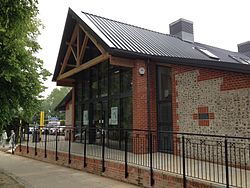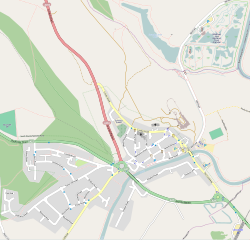Arundel Museum
This article has multiple issues. Please help improve it or discuss these issues on the talk page. (Learn how and when to remove these messages)
|
 Arundel Museum | |
| Established | 1964 |
|---|---|
| Location | Mill Road, Arundel, West Sussex |
| Type | Archaeology, Social History and Geology |
| Website | http://www.arundelmuseum.org |
Arundel Museum is a local museum in the town of Arundel, West Sussex, just inland from the south coast of England. Arundel Museum is run by the Arundel Museum Society, a registered charity. The museum is manned by volunteers and relies on subscriptions, donations and fundraising events for its survival.
The New Museum
The Heritage Lottery Fund has awarded a confirmed grant of £888,000 towards the cost of a new purpose-built museum on a prime site in the centre of the main tourist area of Arundel, adjacent to the river, and opposite the Lower Castle Gate. Building is nearing completion and is to be opened by the Duke of Norkolk on the 24th June 2013.
History
Foundation in the Undercroft
Arundel Museum Society was founded in 1963 by a group of local people. At this time heritage was under threat from new development and was generally undervalued. The Museum Society set out to rescue and conserve as much as possible of Arundel's past, and aimed to create a town museum with the advice of Sussex historian Roy Armstrong and archaeologist Con Ainsworth.
In March 1964, the first museum was established in the old prison cells in the undercroft of the Town Hall. In this evocative but somewhat cramped and damp environment the Museum Society built up displays of the history of Arundel and the surrounding villages. From the beginning, the museum relied totally on volunteer management and stewards. It was a successful small-scale attraction, and one of the first independent local museums in the area, but it had limitations.
The High Street Years
The Museum's first big opportunity came in 1975 when the former Borough Council Offices at 61 High Street became redundant following the major local government re-organisation. Arun District Council offered the Museum Society the opportunity to take a lease on this Grade 2* listed Georgian building. With huge determination, the Society created a new museum which was opened in 1977. At this time AMS became a Charity (No 273790).
During the 1980s and 1990s, Arundel Museum Society faced new challenges. Standards of curatorial care became more demanding. Techniques of conservation were more complex and scientific. With a new national structure for the management of museums and galleries came the requirement for museums to be registered to show that they conformed to minimum standards of good curatorial practice. Arundel Museum was the first in the area to achieve MLA Registration, a considerable achievement.
The Museum expanded into eight galleries. In 2000, the oral history archive gathered by volunteers was published as a book entitled Arundel Voices. A grant was obtained for a new display on the Port of Arundel, and this was accompanied by a new Town Trail way-marked by ceramic plaques by local potter Josse Davies. In 2004, an art gallery was established to stage exhibitions. A regular programme of town walks, lectures and short courses was offered, and school visits were hosted. In 2005, a new formal MLA requirement, Accreditation, was introduced with more demanding benchmarks and the need for extensive documentation and policies to meet specified formats. Arundel Museum was again one of the first in the area to achieve Accreditation, which it did at the first attempt.
An Uncertain Future
From 2000 onwards the Museum had operated under the shadow of an uncertain future. Arun District Council had expressed an intention to sell 61 High Street, and the lease would not be renewed. AMS tried hard to find alternative premises so that a planned move from one building to another might be achieved. Unfortunately this proved impossible. Whilst efforts to develop a new museum carried on in the background, AMS was obliged to leave their premises in the autumn of 2007. Museum Society volunteers, supervised by a consultant curator, undertook the enormous task of packing every item in the collection and transferring these into stores.
For the 2008 and subsequent seasons, Arundel Museum was able to keep a presence in the town by opening in temporary portacabin accommodation, sponsored by Geoffrey Osborne Ltd and Speedy Space Limited, next to the Car Park in Mill Road. In October 2011, it moved again, and again to temporary accommodation, this time in Crown Yard Mews.[1]
Rescue
Returning to 2008, the Angmering Park Estate Trust and the Norfolk Estate came to the rescue and provided us with a vision for the future. They agreed to jointly offer an ideal, prime site for a new building in the centre of the main tourist area. This is the site currently occupied by St Nicholas Hall, opposite the Lower Castle Gate.
So AMS became involved in a two-pronged attack to achieve its aims.
- Firstly, Arundel Museum Society needed plans for the new building. Graham Whitehouse, the architect, created plans for the building and steered us through the planning process, giving his time at no charge. Jonothan Potter of Potter Associates, worked closely with the museum to use cutting edge design and modern technology to develop an innovative design concept for the internal displays.
- Secondly, Arundel Museum Society needed to embark on a major fundraising drive to raise a total of £1.6 million to build and fit out its new permanent home in the heart of Arundel. The first step was to apply for funding from the Heritage Lottery Fund (HLF).
Planning consent was obtained in March 2009. Early in 2010, the news was received that the first round bid that the Society had made to the HLF had been successful. This meant that the HLF awarded the Society a grant of £102,800 to develop and submit more detailed development plans and apply for up to a further £888,000. The second round bid was submitted to the HLF in November.
At the end of March 2011, the Society heard that the second round application to the Heritage Lottery Fund for £888,000 had been granted, subject to contract, towards the project totaling £1,414,500. This grant, together with a £385,500 from Arun District Council, £50,000 that was raised locally last year, and funding from other sources, has provided sufficient funding for the building to go ahead.
In October 2011 the museum moved again from its Portacabin to temporary accommodation in Crown Yard Mews where the museum took on the roll as tourist information point for Arundel.
Construction began early in 2012, with the demolition of St Nicholas Hall in February. Next there was an archaeological investigation and building began shorty after the investigation is complete and its results known.[2]
See also
- Arundel Museum website
- Arundel Museum's Facebook page
- Amberley Museum & Heritage Centre
- Arundel Castle
References
- ^ Arundel Museum Moves Into Its New Premises — A Car Park Portakabin, Veronica Cowan, Culture 24, UK, 17 March 2008.
- ^ Sussex Museums

